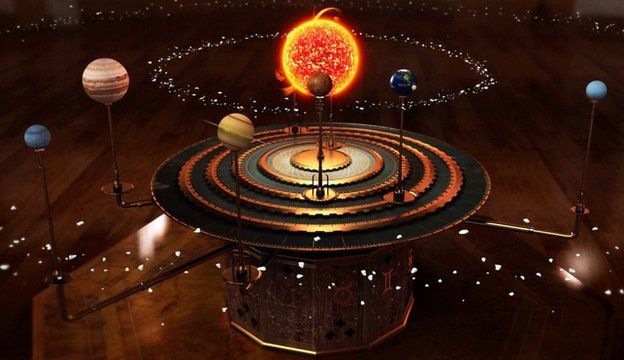Lucky Earth survived cosmic pinball
- Published

Rogue alien planets are forcing astronomers to rethink the birth of our Solar System. What's emerging is a tale of hellfire, chaos and planetary pinball - and it's a miracle our Earth survived.
Hunting for alien planets is big business. Since the first exoplanet was discovered in 1995, astronomers around the world have been searching for those elusive Earth-like planets that could harbour life.
The tally of planets found is staggering. So far, more than 1,800 confirmed planets have been discovered orbiting around other stars in our galaxy (the latest figure from Nasa is 1,816 planets around 1,117 stars).
Among them, are a few rocky planets in the magical "Goldilocks" zone where water can remain in the liquid state, and life could evolve.
It's no surprise to astronomers that these planets exist. But what has come as a shock is that many of these exoplanets seem to break all the rules.
Dr Christopher Watson, from Queen's University, Belfast, is at the forefront of research into these bizarre new worlds.
"They're very strange," he told the BBC's Horizon programme.
"These are nothing like our Solar System, and in some cases, I think really science fact can be a lot weirder than science fiction."
Two hundred light-years away from Earth is a strange world called Kepler 16b. It is a planet with two suns, much Luke Skywalker's home planet - Tatooine.
Then there is Kepler 78b, a rocky planet about the size of Earth, but so close to its star that it completes an orbit once every eight-and-a-half hours. As a result, it is just a seething ball of lava.
Most baffling of all have been the "Hot Jupiters" - giant gas planets in impossible orbits close to their star. Watson, along with most of the astronomical community, was initially baffled: "They were right up against their host star and it's amazing. They really shouldn't be there."
The trouble with these rogue planets is that they seem to break the laws of physics. It's simply not possible for them to form that close to a star.
But, if you eliminate the impossible, then whatever remains, however improbable, must be the truth. The startling conclusion reached by Dr Watson and others is that the planets formed further away, and then migrated in to where we see them today. They changed orbit.
This idea that planets could change orbit, moving closer or further away from their star, turned astronomy on its head and led to one of the biggest rethinks since the time of Copernicus and Galileo.
It led astronomers like Dr Kevin Walsh, from the Southwest Research Institute in Boulder, Colorado, to question everything about the birth and evolution of our own Solar System.
"When we started finding planets in places we thought you could never possibly form a planet, we had to go back to the drawing board and say, 'wow, planets can move, planets can really move. Maybe that happened here'," he says.
Since the time of Galileo, we have assumed that the planets in our Solar System follow stable, fixed orbits. We assumed that the planets were formed where we find them now - from the left-over dust and gas when the Sun burst into life. We assumed that our Solar System has, for four-and-a-half billion years, been a peaceful haven, stable for sufficient time to enable life to evolve on Earth.
And yet there are some nagging mysteries about our own system of planets that have never been explained. Mars, for example, is much smaller than we would expect; the asteroid belt is divided into two neat bands - an inner band of rocky material, and an outer band of icy lumps.
New narrative
No-one ever found a satisfactory explanation for these mysteries, and yet they are clues to a turbulent history that astronomers are beginning to uncover.
Since the discovery of migrating exoplanets, planetary scientists have proposed new models for the formation of our Solar System.
They suggest that, far from being a peaceful and stable system with fixed orbits, our Solar System underwent periods of chaos, with Jupiter, the big bully of the Solar System, calling the shots.
"The Solar System is not this nice, safe, quiescent place, but can go through periods of intense violence," says Dr Hal Levison of the Southwest Research Institute in Boulder.
He believes it's time to re-examine the evidence with fresh eyes: "Sometimes the blood spattered on the wall can tell you more about what happened than the body lying on the floor."
According to Dr Walsh, Jupiter may have undertaken a wild journey through the Solar System, spreading havoc, stunting the growth of Mars and scattering everything in its path.
'Dice roll'
With a planet the size of Jupiter travelling freely through the system of planets, the outcome would have been far from certain.
"The Solar System could have done a lot of different things. It could have evolved in a lot of different ways. We could have ended up with our Jupiter right next to the Sun," he explains.
The latest evidence suggests our Solar System underwent a period of chaotic upheaval, before settling down to the stable system we see today. Our own home, planet Earth - in the perfect place for life to evolve - was lucky to survive.
Dr Walsh comments: "Getting an Earth where we have our Earth today was not a given when this whole Solar System started."
So, astronomers are left with the question - how common is a solar system like ours?
There may be plenty of planets out there. But getting a stable, ordered arrangement like our own Solar System, could just be a lucky roll of the dice.
You can watch Horizon: Secrets of the Solar System on BBC2 on Tuesday 3 March at 21:00.
- Published30 October 2013
- Published29 August 2012
- Published24 October 2013